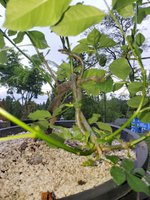ShadyStump
Imperial Masterpiece
I would keep the branch it turns into trimmed back until you cut the second trunk off. Even then, there's still a decent chance it could cause some inverse taper.
Tough call because it's in just the right spot to help heal the wound from chopping the second trunk, and for a lower branch like you said.
The one's down by the base are best for sacrifice branches that will help widen the base and might also balance against the potential reverse taper just mentioned, but I don't think they'd make a good part of the design.
Tough call because it's in just the right spot to help heal the wound from chopping the second trunk, and for a lower branch like you said.
The one's down by the base are best for sacrifice branches that will help widen the base and might also balance against the potential reverse taper just mentioned, but I don't think they'd make a good part of the design.


















